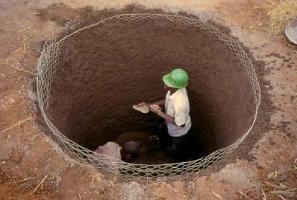
What’s the best, most efficient way to build water tanks? That question has been burning in my mind since seeing the extent of water shortages firsthand on my recent trip to Vanuatu. While looking and thinking about possible solutions, I’ve found numerous good ideas on the Internet such as this underground ferrocement tank made with mortar and chicken wire. This wouldn’t work in Vanuatu and on many other islands due to the rocky soil; however, it will work in many other areas. I love the simplicity of this method.
“A simple and cheap ground tank can be made by excavating a cylindrical hole and plastering it with mortar cement onto chicken mesh (ferro-cement).”
Read more at the source: Infonet-biovision.org

Thanks for the good and new ideas in the construction industry.My question is? How is collected water drained from the tank to be used. Thank you
There would need to be a drain plumbed to the bottom of the tank before the ferrocement is applied, and then this drain would need to be accessable at some point where gravity will feed it, or a pump can bring the water up.
ferrow cement is best for water tanks and bio digesters
Am a pensioneer and have been training people on building water tank with reinforced concrete. I have interest in your technology of using the ferrocement type to construct under ground tanks. Can you guide me to build a 5 cubic meter underground tank for grey water filtration. Grateful.
I suggest that connect with the folks at http://www.ferrocement.net/ to find out more about this.
This technique was used to build houses, as well as boats large and small, that are extremely durable and long lasting.
If you’re building an earthbag house, consider a shed style ferro-cement double roof. The empty space between the two thin roofs could be filled with insulation. If you live in a hot climate you can just leave this space empty, which would allow air to circulate freely, dispersing the heat of the top roof.
It’s always confused me as to why we’re not doing it any more – all I can figure is that it was too efficient so that building trades/stores lost out on a lot of money, so they lobbied against it somehow.
That’s basically what I’ve been saying for years about ferrocement. If it’s strong enough to build boats then it’s strong enough for waterproof roofs. Sometimes people use incorrect ferrocement making methods and then run into problems. That doesn’t mean ferrocement doesn’t work. It means you have to learn and apply the correct methods.
Mainstream builders don’t use ferrocement roofs probably because the final appearance is not as aesthetically desirable as say tile, metal roofing, etc. It lacks that crisp, clean manufactured look most people seem to desire.
Dear sir ,few days back my email adress was hacked.I made a new account. I am missing your daily digest very badly. Pl start sending it on my e mail above.
kindest regards,
khan
You’ll have to resubscribe. Look on the right side of the page and hit the Subscribe button.
Looks good.